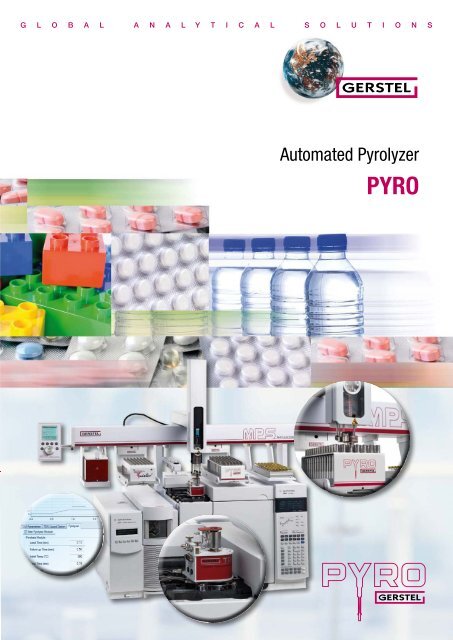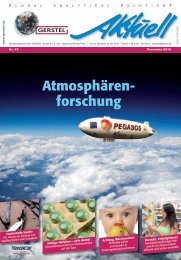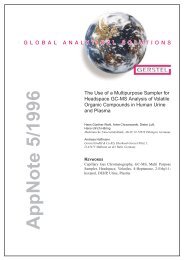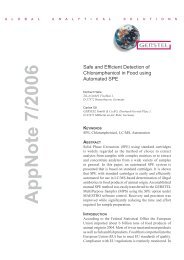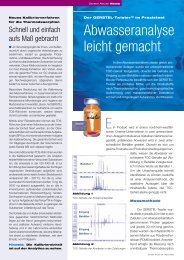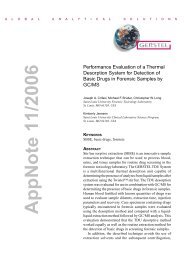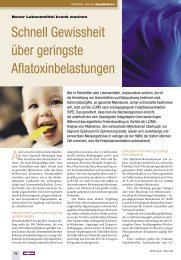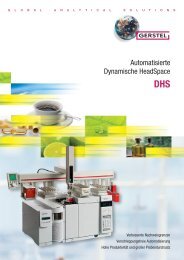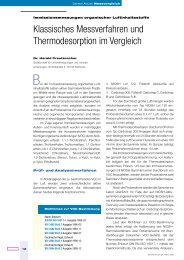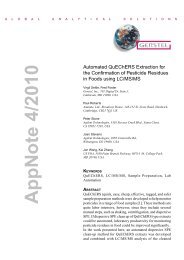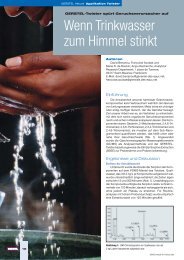PYRO flyer - Gerstel
PYRO flyer - Gerstel
PYRO flyer - Gerstel
Create successful ePaper yourself
Turn your PDF publications into a flip-book with our unique Google optimized e-Paper software.
Automated Pyrolyzer<br />
<strong>PYRO</strong>
Automated Pyrolysis System<br />
GERSTEL <strong>PYRO</strong><br />
The GERSTEL <strong>PYRO</strong> enables highly flexible and efficient automated pyrolysis of solids and liquids at up to 1000 °C<br />
combined with determination in a GC/MS system of the thermal decomposition products. If required, thermal desorption<br />
and pyrolysis of the same sample can be performed in sequence, enabling the analyst to obtain the cleanest<br />
possible pyrogram and the maximum amount of information in the shortest possible time. Some key areas in which<br />
the <strong>PYRO</strong> is used are material testing; production quality control; product development; and forensic science.<br />
Efficient and accurate analysis<br />
When combined with the industry standard<br />
GERSTEL MultiPurpose Sampler MPS, up to 196<br />
samples can be pyrolyzed automatically in one<br />
batch. With just one method and one sequence<br />
table the analyst can set up the complete system<br />
including thermal desorption, pyrolysis, and<br />
GC/MS analysis. This reduces the risk of error and<br />
enables a highly efficient work-flow, while providing<br />
sensitive and reliable results. The Pyrolyzer is<br />
very easy to operate: The sample is placed in a<br />
sample holder, which is mounted onto the TDU<br />
pyrolysis transport adapter and placed in the<br />
MultiPurpose Sampler <strong>PYRO</strong> tray. The sample is<br />
then automatically inserted into the TDU Pyrolyzer.<br />
Pyrolysis break-down products are transferred directly<br />
to the GC column in split mode or refocused<br />
in the GERSTEL Cooled Injection System CIS before<br />
being introduced as a narrow band onto the<br />
GC column for separation. The GERSTEL <strong>PYRO</strong><br />
can also be used for manual operation with the<br />
TDU as needed.<br />
Wide pyrolysis temperature<br />
range<br />
<strong>PYRO</strong> performs standard pulsed pyrolysis at<br />
temperatures from 350 °C to 1000 °C. The temperature<br />
can be varied from sample to sample in<br />
order to analyze different kinds of samples in one<br />
batch; to perform sequential pyrolysis on multiple<br />
identical samples in series; or to perform fractionated<br />
pyrolysis on a single sample for more indepth<br />
information. In addition to pulsed pyrolysis,<br />
programmed heating can be specified at rates<br />
ranging from 0.02 to 100 °C/s. Optimal analysis<br />
conditions can be chosen for each sample<br />
type and for every conceivable matrix. A thermal<br />
desorption step can be performed in the<br />
temperature range from ambient to 350 °C prior<br />
to pyrolysis to purge VOCs from the sample or for<br />
solvent venting.<br />
Integrated split interface and<br />
cryo trap<br />
Pyrolysis breakdown products are transferred to<br />
the GC/MS system using the GERSTEL Cooled Injection<br />
System (CIS) PTV-type inlet. The CIS can be<br />
used either simply as a heated split interface or as<br />
an intermediate cryofocusing trap for trace analytes.<br />
A wide range of concentrations and sample<br />
amounts can be handled by the <strong>PYRO</strong> system<br />
while ensuring best possible recovery, excellent<br />
GC separation and maximum information content.<br />
Low sample-to-sample<br />
carry-over<br />
The valve-free liner-in-liner concept eliminates<br />
sample-to-sample carry-over and the TDU and CIS<br />
liners are heated over their entire lengths ensuring<br />
best possible recovery. Non-volatile residue is<br />
caught in the CIS liner. From there it can easily be<br />
removed after a user-defined number of analyses<br />
together with the disposable liner. The system at<br />
large is not contaminated. The platinum filament is<br />
connected using Four Conductor Technology ensuring<br />
accurate monitoring of the filament resistance<br />
and accurate temperature control delivering<br />
reliable results at all times. Change over between<br />
standard TDU operation and pyrolysis operation<br />
can be performed in less than ten minutes. If<br />
the liner needs to be changed another 5 minutes<br />
are needed. The complete system including the<br />
GC/MS can be used in a highly flexible manner<br />
to the greatest possible benefit of the analyst and<br />
the laboratory.
TDU<br />
Pyrolyzer<br />
Pyrolyzer<br />
Pulsed Pyrolysis<br />
Temperature<br />
Temperature<br />
Solvent Vent<br />
and Pyrolysis<br />
TDU<br />
<strong>PYRO</strong><br />
<strong>PYRO</strong><br />
CIS<br />
TDU<br />
Time<br />
TDU<br />
Time<br />
CIS cryofocousing or hot split analyte transfer<br />
CIS<br />
Features and Benefits<br />
Efficient automation<br />
➔ Up to 2 x 98 samples analyzed in a single batch<br />
using the MPS<br />
➔ Time and cost savings<br />
➔ Higher sample throughput<br />
➔ Easier method development using automated<br />
multi-method sequence<br />
Standard pulsed pyrolysis<br />
➔ Generates results comparable with existing<br />
pyrolysis data<br />
➔ Enables the use of pyrolysis GC libraries<br />
Sequential pyrolysis<br />
➔ Pyrolysis of multiple identical samples in series<br />
under varying conditions<br />
➔ Provides more in-depth information on unknown<br />
samples.<br />
➔ Easy method development<br />
Fractionated pyrolysis<br />
➔ Multiple pyrolysis steps performed on a single<br />
sample at increasing temperatures<br />
➔ Provides more in-depth information, e.g. for multicomponent<br />
samples.<br />
Thermal desorption with solvent venting<br />
and pyrolysis of the same sample<br />
➔ Thermal desorption analysis and pyrolysis is<br />
performed on a single sample resulting in separate<br />
GC/MS chromatograms<br />
➔ Sample is purged and cleaned using thermal<br />
desorption prior to the pyrolysis step<br />
➔ A clean pyrolysis profile is obtained without<br />
interfering contaminants that are unrelated to the<br />
macromolecular structure<br />
➔ Suitable e.g. for polymers in solution, enabling<br />
exact and reproducible sample amounts to be<br />
introduced<br />
➔ Automated drying of wet or humid samples, saves<br />
time by eliminating external drying step<br />
➔ Clearer and more accurate information is obtained<br />
from the sample<br />
Dedicated sample holders available for<br />
liquids and solids<br />
➔ Flexible use for a wide range of sample types<br />
➔ Best possible sample introduction<br />
➔ Supports relatively large sample amounts; samples<br />
can be introduced in solution using a syringe for<br />
better accuracy<br />
➔ Easy sample preparation and introduction saves<br />
time and improves productivity<br />
A<br />
A<br />
B<br />
B<br />
Pyrolysis tube for solid samples<br />
Pyrolysis vial for liquid and solid samples<br />
Split- or splitless operation<br />
➔ Accurate analysis results across a wide range of<br />
concentrations and sample amounts<br />
➔ Enables solvent vent mode for analyte concentration<br />
& sample clean-up prior to pyrolysis<br />
➔ Optimal transfer of analytes to the GC column<br />
depending on the analysis requirements<br />
Selectable cryo trapping<br />
➔ Analyte focusing directly in the CIS liner provides<br />
improved peak shape for medium volatility range<br />
➔ Reliable results and more information, especially<br />
for volatiles and trace analytes<br />
User defined pyrolysis<br />
temperature from 350-1000 °C<br />
➔ Optimal temperature can be chosen for each<br />
sample<br />
➔ Meaningful and accurate results<br />
➔ Different samples or sample types can be analyzed<br />
at different temperatures in one automated batch,<br />
saving time and improving productivity<br />
➔ Samples can be analyzed at different temperatures<br />
in one automated batch for fast method development<br />
and for unknown samples<br />
Flexible and proven resistance<br />
heating using Pt filament<br />
➔ User defined pyrolysis temperature from<br />
350-1000 °C<br />
➔ User defined heating rate from 0.02-100 °C/s in<br />
steps of 0.01 °C/s or pulsed heating<br />
➔ Easy method optimization, any temperature can be<br />
chosen by mouse-click<br />
➔ Highly flexible system, multiple sample types can<br />
be analyzed in one automated sequence without<br />
hardware changes<br />
Liner in liner system<br />
➔ No transfer line between pyrolyzer and GC/MS inlet<br />
➔ Simple and reliable system with less active surface<br />
and negligible memory effects<br />
➔ Less maintenance required, higher uptime. Heavy<br />
residue is caught on the quartz wool in the easily<br />
replaceable GC liner<br />
➔ Efficient flow management, helps eliminate overloading<br />
of GC system by mg-level sample amounts<br />
➔ Better accuracy and more reliable results
Flexible modular system<br />
➔ Fast change over between pyrolysis, standard TDU<br />
and liquid introduction operation<br />
➔ Different samples and sample types can be<br />
analyzed using the system<br />
➔ Best possible system utilization and return on<br />
investment (ROI)<br />
➔ Enables fast and flexible response to new tasks,<br />
for example, in a trouble-shooting environment<br />
➔ As needs change, the system is easily expanded to<br />
meet new requirements saving cost<br />
➔ TDU/<strong>PYRO</strong> configuration for manual operation<br />
available<br />
Small foot-print, mounted on<br />
top of GC/MS<br />
➔ No additional bench space required, saves cost<br />
➔ Logistically an easy addition to existing instruments,<br />
no need to rearrange the lab<br />
Thermal desorption prior to pyrolysis eliminates interfering<br />
contaminants, in this case C2 - C4 carboxylic<br />
acids<br />
Optional GC back flush<br />
➔ Interfering compounds can be kept out of the GC<br />
column and MS during pyrolysis<br />
➔ Back flush of unwanted high-boilers from GC<br />
column shortens GC runs and keeps the GC/MS<br />
clean<br />
No valve in sample flow path<br />
➔ No memory effects<br />
➔ Improved recovery of high-boiling compounds, less<br />
discrimination<br />
➔ Reliable and accurate results over a wide boiling<br />
range<br />
MAESTRO pyrolyzer method screen<br />
MAESTRO control<br />
➔ Integrated software user interface with one method<br />
and one sequence table for the entire analytical<br />
system including GC/MS<br />
➔ Simple control and operation<br />
➔ Less risk of error since only one method and only<br />
one sequence table is required


